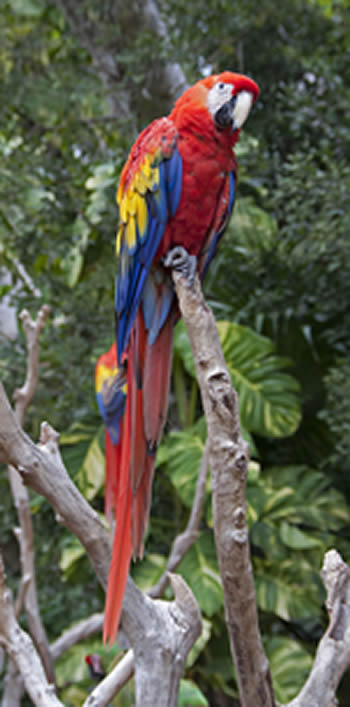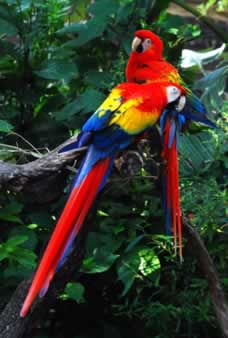Scarlet Macaw
Ara Macao

Kingdom: Animalia
Phylum: Chordata
Class: Aves
Order: Psittaciformes
Superfamily: Psittacoidea
Family: Psittacidae
Subfamily: Arinae
Tribe: Arini
Genus: Ara
Species: Ara macao
Common name: Scarlet Macaw
Geographical Location: Scarlet Macaw are found in humid lowland subtropical rain forests (below 1,000m), open woodlands, river edges, and savannas of Central and South America. They can be found from southern Mexico to as far as northeastern Argentina. It is most common throughout the Amazon basin (Slud, 1964)
Physical Characteristics: Scarlet Macaw is arguably one of the most beautiful and colorful birds in the world. As the name suggest, their plumage is mostly bright red, but the rum and tail-covert feathers are light blue, the greater upper wing coverts are yellow, the upper sides of the flight feathers of the wings are dark blue as are the ends of the tail feathers, and the undersides of the wing and tail flight feathers are dark red with metallic gold iridescence. Scarlet Macaw have a strong, large bill. The upper mandible of the bill is whitish with a black tip and base, and the lower mandible is black. Males and females are alike except for the bill of the males might be larger and the tail feathers of males may be longer than females. Juveniles and adults are similar in appearance, but can be distinguished by juveniles having a shorter tail and dark grey-brown eyes rather than the yellow eyes adults have. Weight can range from 2 - 5.5lbs. Scarlet Macaw with their wide strong wings can reach speeds of 35 miles per hour (Juniper and Parr, 1998).
Longevity: Typical average life span is between 40 and 50 years in the wild. In captivity Scarlet Macaw can live up to 75 years (Flower, 1938).
Behavior and Reproduction: The scarlet Macaw are usually seen in pairs or a small family which may join a large flock of up to 30 birds. At night the flock sleeps together, but partners maintain a monogamous bond for life. Mates are rarely found alone except for when the female is incubating and the male is feeding. Scarlet Macaw usually breeds between October and April depending on the location. Nests are usually in the canopy of the rainforest. The Scarlet Macaw may lay one to four white eggs, and females incubate for about five weeks. Chicks fledge from the nest about 90 days after hatching and do not leave parents until a year later. Scarlet Macaws communicate with different postures and vocalizations. They also have excellent vision and hearing (Juniper and Parr, 1998).

Photo by Matt Romack
Diet: Ara maco primarily eats fruits and nuts but can also consume a range of seeds, flowers, nectar, bark and leaves. They are known to eat fruits before they are ripe. Premature fruits have tougher skin and pulp which makes it difficult for many birds to access. Because they are able to access this fruits before other birds, this gives them a competitive advantage (Juniper and Parr 1998). Scarlet Macaws occasionally consume clay found on river banks, this aids in digestion by protecting the Macaw against toxic compounds present in the diet (Burge rand Gochfeld, 2003)
Ecology: Scarlet Macaw’s are valuable for their meat and colorful plumage. Also, they are popular in the pet trade. The Scarlet Macaw is a CITES I listed species, meaning that they are illegal to buy, sell or use in any commercial activities without specific special permits (Marineros and Vaughan, 1995).
Endangerment: The population of Scarlet Macaw’s has been decreasing in the past 50 years due to a combination of factors, particularly hunting for food and feathers, illegal capture for the pet trade, and the destruction of habitat through deforestation (Marineros and Vaughan, 1995).
Conservation: Various efforts have been made to slow population declines of scarlet Macaws. The World Parrot Trust was formed in 1989 to protect parrots in their natural environment. In Costa Rica, the Association for Parrot Protection (LAPPA) was set up in 1995 as a community based conservation organization dedicated to protecting the scarlet Macaw by guarding their nests, installing artificial nest boxes, improving habitats, scientific research, environmental education and much more. (Nemeth and Vaughan, 2005) In Guatemala, the Wildlife Conservation Society (WCS) is using similar measures to try and save the scarlet Macaw population from local extinction by the pet trade (Gonzalez, 2003).
Research: Research is being done currently to improve the birds habitat and to stop the decline of the Scarlet Macaw’s population (Anonymous).
Reference:
Please note that the following references may have either been removed or relocated by the webpage owners since the time this student report was created.
Anonymous. Wildernessclassroom.com< http://www.wildernessclassroom.com/students/archives/2005/03/macaws.html>
Burger, J. and Gochfeld, M. (2003) Parrot behavior at a Rio Manu (Peru) clay lick: temporal patterns, associations, and antipredator responses. Acta Ethologica, 6: 23 - 34.
Flower, M.S.S., 1938. The duration of life in animals - IV. Birds: special notes by orders and families, in Proceedings of the Zoological Society of London. 195-235
González, J.A. (2003) Harvesting, local trade, and conservation of parrots in the Northeastern Peruvian Amazon. Biological Conservation, 114(3): 437 - 446.
Hisgett, Tony. 2010. “Macaw in Yucatan, Mexico”. photo. Flickr.com. 18 February 2010. 30 May 2012 http://flickr.com/photo/37804979@N00/4384476529
Juniper, T. and Parr, M. (1998) Parrots: A Guide to Parrots of the World. Pica Press, Sussex.
Leonel Marineros & Christopher Vaughan (1995). "Scarlet Macaws of Carara". In Joanne Abramson, Jorgen B. Thomsen & Marsha Mello. The Large Macaws: Their Care Breeding and Conservation. Fort Bragg, California: Raintree Publications. pp. 445–467. ISBN 978-0-9635964-0-6.
Romack, Matthew. 2008. “Scarlet Macaw”. photo. Flickr.com. 24 February 2008. 30 May 2012. http://flickr.com/photo/11324320@N08/2291461837
Slud, P. 1964. Birds of Costa Rica. New York: Bulletin of the American Museum of Natural History, Volume 128.
Vaughan, C., Nemeth, N.M., Cary, J. and Temple, S. (2005) Response of a scarlet macaw Ara macao population to conservation practices in Costa Rica. Bird Conservation International, 15: 119 - 130.